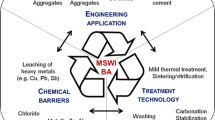Abstract
In real-life construction projects, the utilization of different types of waste derived aggregates can often be falsely considered as utilization, but in fact, it is merely dum** the potentially high value material from one site to another. For example, building highway noise barriers with waste derived aggregates cannot be considered as utilization. In this study, a more advanced approach was chosen in order to create aggregate like products from recovered municipal solid waste incineration (MSWI) bottom ash (BA) and thus potentially increase their value and image in civil engineering applications. MSWI BA from one waste incineration plant in Finland was first treated with a Dutch dry treatment technology called advanced dry recovery. This process separates non-ferrous and ferrous metals from MSWI BA and generates mineral fractions of different grain sizes. These mineral fractions may not be used separately, for example, in the unbound structural layers of roads due to the strict grain size distribution requirements of these civil engineering structures. Hence, different combinations were designed from these BA mineral fractions using the mathematical proportioning of aggregates. The aim was to create aggregate like products from this waste material for different structural layers (filtration, sub-base and base) of, for example, road and field structures. Three mixtures were chosen based on their correspondence to the grain size distribution requirements of natural aggregates and further analyzed in the laboratory from their technical, mechanical and environmental point of view. The leaching of chrome (Cr) and chloride (Cl−) exceeded the Finnish emission boundary values for utilization of certain types of ashes in civil engineering. On the other hand, the technical and mechanical properties of these mixed bottom ash products were considered suitable to be used, for example, in the unbound structural layers of the interim storage field in a waste treatment center. In such location, the leaching potential of harmful substances can be further studied and verified in a larger scale.





Similar content being viewed by others
References
Astrup, T.: Pretreatment and utilization of waste incineration bottom ashes: Danish experiences. Waste Manag 27, 1452–1457 (2007). doi:10.1016/j.wasman.2007.03.017
ISWA (International Solid Waste Association): Management of bottom ash from WTE plants, an overview of management options and treatment methods. http://www.iswa.org/uploads/tx_iswaknowledgebase/Bottom_ash_from_WTE_2006_01.pdf (2006). Accessed 24 January 2016
Ministry of Environment: Kohti kierrätysyhteiskuntaa: Valtakunnallinen jätesuunnitelma vuoteen 2016, 31/2008 (Towards recycling society, national waste plan by year 2016, report 32/2008. https://helda.helsinki.fi/bitstream/handle/10138/38363/SY_32_2008.pdf?sequence (2008). Accessed 24 January 2016
Berkhout, S.P.M., Rem, P.C.: Dutch patent NL2001431 (2009)
de Vries, W., Rem, B.C.: ADR—a classifier for fine moist materials. In: Gente, V., La Marca, F. (eds.) Separating Pro-Environment Technologies for Waste Treatment, Soil and Sediments Remediation, pp. 43–58. Bentham Science Publishers, Sharjah (2013)
RTS Rakennustietosäätiö: InfraRYL 2010. Infrarakentamisen yleiset laatuvaatimukset, Osa 1 Väylät ja alueet (General Quality Criteria for Infrastructure Construction, Part 1 Routes and Areas). Rakennustieto Oy, Helsinki (2010)
Gy, P.: Sampling of Particulate Materials: Theory and Practice. Elsevier Scientific Publishing Company, Amsterdam (1979)
Sormunen, L.A., Rantsi, R.: To fractionate municipal solid waste incineration bottom ash: key for utilisation? Waste Manag. Res. (2015). doi:10.1177/0734242X15600052
PANK ry (Päällystealan neuvottelukunta). Asfalttinormit 2011 (Asphalt norms 2011). Edita, Vantaa (2011)
SFS-EN 13286-2: Unbound and hydraulically bound mixtures. Part 2: test methods for laboratory reference density and water content. Proctor compaction, pp. 1–29. Finnish Standards Association, Helsinki (2013)
SFS-EN 933-1: Test for geometrical properties of aggregates. Part 1: determination of particle size distribution. Sieving method, pp. 1–18. Finnish Standards Association, Helsinki (2012)
SFS-EN 1097-5: Tests for mechanical and physical properties of aggregates. Part 5: determination of the water content by drying in a ventilated oven, pp. 1–11. Finnish Standards Association, Helsinki (2008)
ASTM D5334-14 Standard test method for determination of thermal conductivity of soil and soft rock by thermal needle probe procedurer
SFS-EN 1097-2: Tests for mechanical and physical properties of aggregates: Part 2: Methods for the determination of resistance to fragmentation, pp. 1–34. Finnish Standards Association, Helsinki (2010)
SFS-EN 1367-1: Tests for thermal and weathering properties of aggregates. Part 2: Determination of resistance to freezing and thawing, pp. 1–12. Finnish Standards Association, Helsinki (2007)
Ullidtz, P.: Modelling Flexible Pavement Response and Performance. Polyteknisk Forlag, Lyngby (1998)
Tiehallinto, Tierakenteen suunnittelu, Suunnitteluvaiheen ohjaus (Road design guidance): http://alk.tiehallinto.fi/thohje/pdf/2100029-v-04tierakenteensuunn.pdf (2004). Accessed 20 February 2016
Brinkreve, R.B.J., Engin, E., Swolfs, W.M.: PLAXIS 3D 2012. User’s manuals. Plaxis bv, Delft (2012)
Bathe, K.J.: Finite Element Analysis in Engineering Analysis. Prentice-Hall, New Jersey (1982)
Kalliainen, A., Kolisoja, P., Haakana, V.: Effect of tire configuration on the performance of a low volume road exposed to heavy axle loads—mechanical modelling. Transp. Res. Rec. 2474, 166–173 (2015)
Kolisoja, P., Kalliainen, A.: Modelling of plastic culvert and road embankment interaction in 3D. Accepted to be published in the proceedings of the 3rd international Conference on Transportation Geotechnics (ICTG), Guimaraes, Portugal, 4–7 September (2016)
Kalliainen, A., Kolisoja, P., Nurmikolu, A.: Modeling of the effect of embankment dimensions on the mechanical behaviour of railway track. In: Proceedings of the 2010 Joint Rail Conference, Urbana, Illinois, USA, 27–29 April (2010)
CEN/TS 14405: Characterization of waste. Leaching behaviour tests. Up-flow percolation test (under specified conditions), pp. 1–25. Finnish Standards Association, Helsinki (2004)
SFS-EN 1484: Water analysis. Guidelines for determination of total organic carbon (TOC) and dissolved organic carbon (DOC), pp. 1–15. Finnish Standards Association, Helsinki (1997)
Government Decree of Finland concerning the recovery of certain wastes in earth construction, Ministry of the Environment, (591/2006). https://www.finlex.fi/en/laki/kaannokset/2006/en20060591.pdf (2006). Accessed 4 January 2016
Lamers, F., Kokmeijer, E: Expert vision upgrading EfW bottom ashes. DNV Kema Energy and Sustainability, 74102802-CES/TPG 13-0489, Arnhem (2013)
Michel, L.: Decree of November 18th 2011 relating to recycling in road engineering of blast-furnace slags of incineration of non-dangerous waste. http://www.legifrance.gouv.fr/affichTexte.do?cidT (2011). Accessed 17 June 2016
Andersland, O.B., Anderson, D.M.: Geotechnical Engineering for Cold Regions. McGraw-Hill, New York (1978)
Tiehallinto, tie-ja geotekniikka. Tietoa tiensuunnitteluun nro 71D, tien päällysrakenteen mitoituksessa käytettävät moduulit ja kestävyysmallit (Information for pavement design nro 71D, the modulus and sustainability models used in the pavement design). http://alk.tiehallinto.fi/thohje/tts71d.pdf (2005). Accessed 4 January 2016
Bendz, D., Arm, M., Flyhammar, P., Westberg, G., Sjostrand, K., Lyth, M., Wik, O.: Projekt Vandora: En studie av langtisdegenskaper hos en vag anlagd med bottenaska fran avfallsborbranning. Varmefors service AB, Stockholm (2006)
Chandler, A.J., Eighmy, T.T., Hjelmar, O., Kosson, D.S., Sawell, S.E., Vehlow, J., van der Sloot, H.A., Hartlén, J.: Municipal Solid Waste Incinerator Residues (Studies in Environmental Science), pp. 1–1006. Elsevier Science B.V., Amsterdam (1997)
Ahmed, A.T., Khalid, H.A., Ahmed, A.A., Chen, D.: A lysimeter experimental study and numerical characterization of the leaching of incinerator bottom ash waste. Waste Manag 30, 1536–1543 (2010). doi:10.1016/j.wasman.2010.03.034
Hjelmar, O., Holm, J., Crillesen, K.: Utilisation of MSWI bottom ash as sub-base in road construction: first results from large-scale test site. J. Hazard. Mater. A139, 471–480 (2007). doi:10.1016/j.jhazmat.2006.02.059
Dabo, D., Badreddine, R., De Windt, L., Drouadaine, I.: Ten-year chemical evolution of leachate and municipal solid waste incineration bottom ash used in a test road site. J. Hazard. Mater. 172, 904–913 (2009). doi:10.1016/j.hazmat.2009.07.083
Acknowledgments
This work was supported by the Green Growth program of Finnish Funding Agency for Technology and Innovation (Tekes) under Grant 1105/2013/2013. The authors would like to thank all the members of joint research project for their contribution, valuable comments and suggestions throughout the whole investigation.
Funding
The investigations were carried out within a joint research project funded by the Green Growth program of Finnish Funding Agency for Technology and Innovation (TEKES 1105/2013/2013).
Author information
Authors and Affiliations
Corresponding author
Ethics declarations
Conflicts of interest
Authors Sormunen and Rantsi are employed by Suomen Erityisjäte Oy, which is the responsible leader of the joint research project.
Rights and permissions
About this article
Cite this article
Sormunen, L.A., Kalliainen, A., Kolisoja, P. et al. Combining Mineral Fractions of Recovered MSWI Bottom Ash: Improvement for Utilization in Civil Engineering Structures. Waste Biomass Valor 8, 1467–1478 (2017). https://doi.org/10.1007/s12649-016-9656-4
Received:
Accepted:
Published:
Issue Date:
DOI: https://doi.org/10.1007/s12649-016-9656-4




